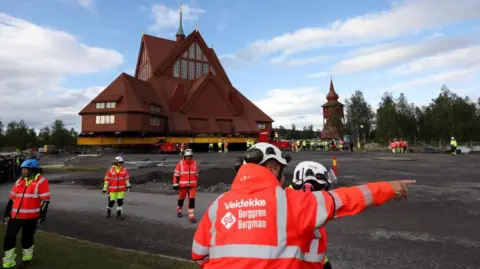In a remarkable endeavor reflecting both engineering prowess and community spirit, a 113-year-old church located in the town of Kiruna, Sweden, is embarking on a two-day journey across the city. The church, characterized by its vast red timber structure, is being relocated approximately 5 kilometers (3 miles) due to ground subsidence issues resulting from a century of iron ore mining in the region. This monumental task not only highlights the challenges facing communities reliant on mining but also showcases the determination to preserve cultural heritage.
On a Tuesday morning, the relocation commenced, with the church hoisted onto giant rolling platforms. The structure, built in 1912 and standing 35 meters (115 feet) high and weighing 672 tonnes, is being transported at a maximum speed of 500 meters an hour. The journey poses significant logistical challenges, primarily due to the potential for ground fissures that could threaten the integrity of the old city center if left unattended. Kiruna’s geographic location, lying 145 km north of the Arctic Circle, makes the risk from the mine even more pressing.
The relocation of the church is not an isolated incident; it symbolizes the ongoing transformation of Kiruna, necessitated by the expansion of mining operations by LKAB, the region’s largest employer. The mining company is covering the estimated $1 billion cost of the relocation, which is essential for ensuring the safety of residents and the reliability of local infrastructure. This monumental task has garnered considerable attention, both locally and nationally, creating a unique spectacle that many residents eagerly anticipate.
Among the significant preparations for the move, project manager Stefan Holmblad Johansson has coordinated efforts to widen roads and remove obstacles, such as lampposts and traffic lights. The concern extends beyond the building itself; protecting interior treasures, such as the church’s grand altar painting by Prince Eugen, is paramount. As Johansson notes, the art cannot be removed without risking damage, so it will remain stable and covered inside the church during the transport.
The emotional weight of this relocation is palpable within the community. Sofia Lagerlöf Määttä, a culture strategist and local resident, expressed the sentiment of many when she remarked, “the move has brought back memories of joy and sorrow to us, and we’re now moving those memories with us into the future.” For many in Kiruna, this church has acted as a spiritual anchor and a cultural hub for generations. The vicar of the church, Lena Tjärnberg, shared her heartfelt emotions about the transition, acknowledging the bittersweet nature of leaving the church’s original site, which holds profound significance for the community.
The church relocation reflects a larger narrative of change and adaptation within Kiruna. Since the mid-2010s, several civic structures have been relocated, with some demolished and rebuilt, while others, like the church and historical homes, have been moved intact. This careful approach to preserving the town’s cultural heritage is evident in the planning and execution of the church’s journey. With thousands expected to line the route, including notable figures such as King Carl Gustaf of Sweden, the relocation of Kiruna church is a significant cultural event celebrated by many.
As Swedish television broadcasts the entire journey, the relocation transcends mere physical movement; it becomes an emblem of resilience in the face of inevitable change, serving to unify the community while preserving the cherished history and identity of Kiruna. By embracing such monumental tasks with a blend of tradition and modern engineering, Kiruna is charting a path towards a dynamic future, ensuring that history is not merely discarded but is actively carried forward by generations to come.












